

The U.S. labor market unexpectedly strengthened in November with pickups in employment and wages, deflating hopes for the Federal Reserve to cut interest rates early next year.
Nonfarm payrolls increased 199,000 last month following a 150,000 advance in October, a Bureau of Labor Statistics report showed Friday. The return of striking auto workers helped boost the count by 30,000. The unemployment rate fell to 3.7% and workforce participation edged up. Monthly wage growth rose more than forecast.
| Metric | Actual | Median estimate |
|---|---|---|
| Change in payrolls (MoM) | +199,000 | +185,000 |
| Unemployment rate | 3.7% | 3.9% |
| Average hourly earnings (MoM) | +0.4% | +0.3% |
Health care, leisure and hospitality, and government hiring, in addition to the pickup in manufacturing upon the resolution of the United Auto Workers strike, drove the payrolls gain. Other categories, such as retail, showed tepid growth or outright declines.
The acceleration in payrolls is at odds with recent reports that have depicted a softer hiring pace, an outcome favored by the Fed as it will help rein in demand and tame price pressures.
A separate report Friday showed consumers’ feelings about the economy improved markedly in early December, with a gauge of sentiment from the University of Michigan climbing to a four-month high and topping all forecasts. They also pared back short-run inflation expectations to the lowest level since 2021, and longer-term expectations also receded.
The surprise strength supports policymakers’ desire to keep borrowing costs elevated to ensure inflation returns to target.
Fed officials are widely expected to keep borrowing costs at the highest level in two decades when they meet next week. Chair Jerome Powell has repeatedly pushed back against growing bets of rate cuts early next year, stressing that policymakers will move cautiously but retain the option to hike again. Treasury yields rose sharply after the figures.
“All in all, expectations of many cuts next year that begin in the first quarter will be pared back,” said Derek Tang, an economist with LH Meyer/Monetary Policy Analytics. “Fed policymakers will seize on this to call for patience and a longer hold.”
The solid labor market figures shift the focus to inflation numbers as Fed officials gauge how long to maintain interest rates at this cycle’s peak. A further cooling of price gains would likely help push the central bank toward rate cuts as long as the job market averts a more sustained reacceleration.
“The totality of the data will allow the Fed to remain patient to make sure inflation is moving back to target,” said Yelena Shulyatyeva, senior U.S. economist at BNP Paribas.
Average hourly earnings rose 0.4%, matching the biggest monthly advance this year, and were up 4% from November 2022. Earnings for non-supervisory employees, who make up the majority of workers, also increased 0.4%.
The participation rate — the share of the population that is working or looking for work — rose to 62.8%, driven by men. A further increase in the labor supply could help alleviate wage gains.
The jobs report is composed of two surveys: one of households and one of businesses. The household survey showed a 747,000 surge in employment, far offsetting a decrease in the prior month. A large number of people previously not in the labor force, as well as those previously unemployed, were able to find jobs.
The gain in payrolls, combined with stronger wage growth and a pickup in hours worked, led a broad measure of labor market health to jump 0.7% last month, the most since June. Moreover, a gauge of take-home pay rose 0.3%.
Some people had a difficult time accessing the full set of data from the Bureau of Labor Statistics’ website on Friday morning. Acting Labor Secretary Julie Su said on Bloomberg TV she didn’t know why that was the case, and that the report “reflects continued steady growth in our economy.”

Driven by robust transaction activity amid market turbulence and increased focus on billion-dollar plus targets, Echelon Partners expects another all-time high in 2025.

The looming threat of federal funding cuts to state and local governments has lawmakers weighing a levy that was phased out in 1981.

The fintech firms' new tools and integrations address pain points in overseeing investment lineups, account monitoring, and more.

Canadian stocks are on a roll in 2025 as the country prepares to name a new Prime Minister.

Carson is expanding one of its relationships in Florida while Lido Advisors adds an $870 million practice in Silicon Valley.
RIAs face rising regulatory pressure in 2025. Forward-looking firms are responding with embedded technology, not more paperwork.
As inheritances are set to reshape client portfolios and next-gen heirs demand digital-first experiences, firms are retooling their wealth tech stacks and succession models in real time.
